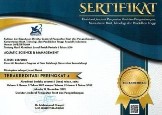Populasi hiu berjalan, Kalabia (Hemiscyllium freycineti), di Perairan Misool, Kabupaten Raja Ampat (Population of the walking shark, Kalabia (Hemiscyllium freycineti), in Misool, Raja Ampat)
Abstract
---
Hiu berjalan (Hemiscyllium freycineti) tergolong dalam genus Hemiscyllium, yang merupakan hewan nokturnal yang hidup di dasar perairan. Hiu berjalan memiliki distribusi terbatas, karena jenis ini tidak mampu berenang menyeberangi laut yang dalam meskipun hanya berjarak beberapa kilometer. Berdasarkan informasi tersebut, maka dilakukan survei kepadatan populasi hiu berjalan di perairan Misool, Raja Ampat, guna memperoleh data populasi dan pemanfaatannya. Penelitian ini dilakukan dengan metode Snorkeling Visual Census dan survei menyusuri garis pantai berbasis Global Positioning System (GPS). Dari hasil survei, didapatkan jumlah ikan hiu berjalan yang tersensus sebanyak 58 individu dengan ukuran yang bervariasi dari terpanjang sekitar 61-70 cm dan ukuran terpendek 20 cm. Ukuran ikan hiu berjalan yang dominan ditemukan ialahdengan panjang tubuh 31-40 cm (sebanyak 16 individu). Survei ini mencakup panjang lintasan 20.003,74 m (20 km), luas area pengamatan 109.592,69 m2, dan lebar lintasan survei 11 m, sehingga kepadatan ikan hiu berjalan yang diperoleh dari hasil survei yaitu 5,29 individu/ha. Hiu berjalan di Misool belum banyak dimanfaatkan, baik secara konsumsi maupun permintaan perdagangan. Dengan demikian, dapat disimpulkan, bahwa tingkat kepadatan hiu berjalan di Misool dalam kondisi tekanan rendah.
Keywords
Full Text:
PDFReferences
ALLEN, G.R., ERDMANN, M.V. and DUDGEON, C.L. (2013) Hemiscyllium halmahera, a new species of Bamboo Shark (Hemiscyllidae) from Indonesia. Journal of Ichtiology, 19 (3), pp. 123-136.
CHODRIJAH, U., PRIHATININGSIH, PANGGA-BEAN, A.S. and HERLISMAN. (2020) Struktur ukuran dan parameter populasi hiu tikus di Selatan Jawa Samudera Hindia. Jurnal Penelitian Perikanan Indonesia, 26 (1).
COMPAGNO, L.J.V. (1984) Shark of the world. An annotated and illustrated catalogue of shark species known to date. Food and Agricultural Organization, pp. 470-472.
FAHMI and DHARMADI (2005) Status perikanan hiu dan aspek pengelolaannya. Oseana, 30 (1),pp 1-8.
HEUPEL, M.R., WHITTIER, J.M. and BENNETT, M.B. (1999) Plasma Steroid Hormone Profiles and Reproductive Biology of the Epaulette Shark, Hemiscyllium ocellatum. Journal of Experimen-tal Zoology 284, pp. 586-594.
HEUPEL, M.R. and BENNETT, M.B. (2007) Estimating Abundance of Reef-Dwelling Sharks: A Case Study of the Epaulette Shark, Hemiscyllium ocellatum (Elasmobranchii: Hemiscyllidae). Pacific Science, 61(3), pp. 383-394.
IUCN (2020) The IUCN Red List of Threatened Species. https://www.iucnredlist.org/search? query= hemiscyllium%20freycineti&searchType =species [Diakses 10/08/2020].
JUTAN, Y., RETRAUBUN, A.S.W., KHOUW, A.S., NIKIJULUW, V.P.H and LATUMAERIS-SA, H.S. (2019) The food composition of Halmahera walking shark (Hemiscyllium halmahera). IOP Conference.
LAST, P.R and STEVENS, J.D. (1994) Shark and rays of Australia. CSIRO, pp.513.
PREHADI, SEMBIRING, A., KURNIASIH, E.M., RAHMAD, R., ARAFAT, D., SUBHAN, B. and MADDUPPA, H.H. (2015) DNA barcoding and phylogenetic reconstruction of shark species landed in Muncar fisheries landing site in comparison with Southern Java fishing port. Biodiversitas Journal of Biological Diversity, 16(1), pp. 55-61.
RAHARDJO, P. (2009). Hiu dan Pari Indonesia. Jakarta: Balai Riset Perikanan Laut.
WAHYUDIN, I., KAMAL, M.M., FAHRUDIN, A., and BUER M. (2019). Analisis Keberlanjutan Perikanan Elasmobranch di Tanjung Luar Kabupaten Lombok Timur. Jurnal Ilmu dan Teknologi Kelautan Tropis, 11(1), pp. 103-116.
DOI: https://doi.org/10.35800/jasm.8.1.2020.30597
Refbacks
- There are currently no refbacks.
INDEXED IN:
PUBLISHER: The JASM is published by Pascasarjana, Universitas Sam Ratulangi, Manado, in collaboration with the Indonesia of Aquatic Resources Management Association (Asosiasi Pengelola Sumber Daya Perairan Indonesia/SIPESUAR). It is printed in each publication as 'Graduate Program, UNSRAT, Manado, Indonesia – Asosiasi Pengelola Sumber Daya Perairan Indonesia'.








